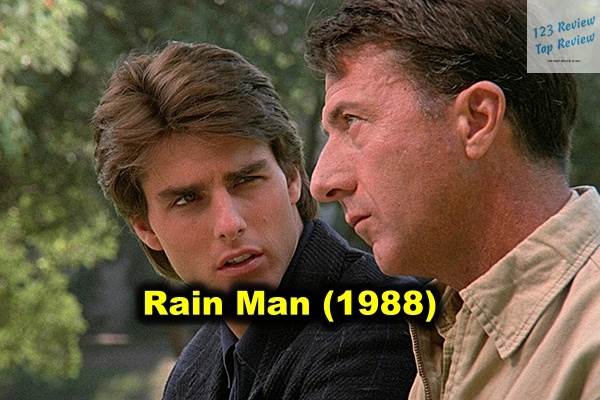In this article, 123 Review delves into the Rain Man (1988) film’s themes of family, acceptance, and personal growth, while also analyzing the standout performances of Tom Cruise and Dustin Hoffman. We discusses the film’s impact on societal perceptions of autism, its cinematic techniques, and its lasting cultural legacy as a significant piece of 1980s cinema.
Overview of Rain Man
Essential Information
Released in 1988, Rain Man is a groundbreaking American drama directed by Barry Levinson, a filmmaker known for his skill in blending human emotion with compelling narratives. The film became an instant classic, not only because of its heartfelt story but also due to the unforgettable performances by its lead actors, Tom Cruise and Dustin Hoffman. Rain Man tells the story of Charlie Babbitt (Cruise), a young, self-centered businessman, and his brother Raymond (Hoffman), an autistic savant with extraordinary mental abilities but significant social challenges.

Written by Barry Morrow and Ronald Bass, the screenplay of Rain Man was crafted with great care to highlight the complexities of autism while simultaneously exploring themes of family, brotherhood, and personal growth. Upon its release, the film was met with critical acclaim, eventually winning four Academy Awards, including Best Picture, Best Director for Levinson, Best Actor for Hoffman, and Best Original Screenplay. It stands as one of the most influential films of the 1980s, not only for its cinematic achievements but also for its impact on the public’s understanding of autism.
Key Cast and Crew
The success of Rain Man can be largely attributed to the talents of its cast and crew, who brought depth and authenticity to the film’s narrative.
- Director: Barry Levinson
- Writers: Barry Morrow, Ronald Bass
- Main Cast:
- Tom Cruise as Charlie Babbitt: A character who begins as a self-centered individual but undergoes significant personal growth throughout the film.
- Dustin Hoffman as Raymond Babbitt: The autistic savant brother, whose performance became iconic for its sensitivity and authenticity.
- Valeria Golino as Susanna: Charlie’s girlfriend, who plays a crucial role in grounding Charlie and offering him a moral perspective.
- Gerald R. Molen as Dr. Bruner: The doctor responsible for Raymond’s care, representing the institutional approach to autism during that era.
Barry Levinson’s direction allowed the story to unfold in a manner that was both intimate and expansive, capturing the emotional journey of the characters while also providing commentary on broader societal issues. The collaboration between Levinson, Morrow, and Bass resulted in a film that was as thought-provoking as it was entertaining.
Themes in Rain Man
Family and Brotherhood
At the heart of Rain Man is the exploration of family dynamics, particularly the complex relationship between brothers. Charlie and Raymond Babbitt are initially strangers to one another, having been separated by circumstances and their father’s decision to institutionalize Raymond. The film delves deeply into the emotions tied to family loyalty, responsibility, and the bond that slowly forms between the two brothers as they embark on a cross-country journey.
Charlie’s initial reaction to Raymond is one of frustration and disbelief, particularly when he learns that Raymond is the beneficiary of their father’s multimillion-dollar estate, leaving Charlie with nothing. This revelation sets the stage for Charlie’s emotional arc, as his greed and sense of betrayal gradually give way to genuine care and responsibility for Raymond. The film portrays the evolution of their relationship with a delicate balance of tension and tenderness, ultimately underscoring the idea that family bonds, though sometimes strained, can be a source of profound personal growth and understanding.
Acceptance and Understanding
Rain Man is also a powerful narrative about acceptance—of oneself, of others, and of the situations life presents. Charlie’s journey from anger and frustration to acceptance and compassion for Raymond is one of the film’s most compelling aspects. Initially, Charlie views Raymond as a burden, someone who complicates his life and stands between him and his inheritance. However, as they spend time together on the road, Charlie begins to recognize Raymond’s unique abilities and the depth of his character beyond his condition.
The film challenges viewers to see beyond Raymond’s autism and appreciate him as a whole person. It confronts the stigma and misunderstandings associated with mental health conditions, particularly autism, by presenting Raymond not as a caricature or a “problem” to be solved, but as a fully realized individual with strengths and vulnerabilities. This theme of acceptance is woven throughout the narrative, making it a central message of the film.
Personal Growth and Transformation
Charlie Babbitt’s character arc is one of significant personal transformation. At the beginning of the film, Charlie is portrayed as a brash, materialistic young man, more concerned with his own financial success than with the well-being of those around him. His decision to take Raymond on a road trip is initially motivated by selfishness—he wants to leverage Raymond’s condition to gain control of the inheritance. However, as the journey progresses, Charlie’s motives shift from financial gain to a genuine concern for his brother.
The road trip serves as a catalyst for Charlie’s personal growth. Through the challenges they face together, Charlie is forced to confront his own flaws—his impatience, his greed, and his inability to connect with others on an emotional level. By the end of the film, Charlie has undergone a profound change. He develops a deep bond with Raymond, one that is based on love, empathy, and a newfound understanding of what truly matters in life. This transformation is a key element of the film’s narrative, providing a powerful commentary on the redemptive power of love and human connection.
Character Analysis
Charlie Babbitt: The Protagonist’s Journey
Charlie Babbitt is the central figure through whom the audience experiences the narrative of Rain Man. His journey is not just a physical one across the United States but also an emotional and psychological one. At the film’s outset, Charlie is depicted as a driven, somewhat unscrupulous businessman who is primarily concerned with his own success. His relationship with his father was strained, leading to years of estrangement and, ultimately, a deep-seated resentment that comes to the fore when he learns of his father’s death and the terms of the will.
Charlie’s decision to kidnap Raymond and take him on a road trip is born out of frustration and greed. He sees Raymond as an obstacle to his inheritance rather than as a brother. However, as they travel together, Charlie is confronted with the realities of Raymond’s condition—his rigid routines, his reliance on strict schedules, and his extraordinary abilities with numbers. These experiences gradually chip away at Charlie’s selfish exterior, revealing a more vulnerable and compassionate side.
The turning point in Charlie’s character arc comes during the moments of crisis on the road. When Raymond becomes distressed in unfamiliar situations, Charlie begins to show genuine concern for his brother’s well-being, rather than seeing him as a means to an end. This shift is subtle but profound, culminating in Charlie’s realization that his relationship with Raymond is more valuable than any financial gain. By the film’s conclusion, Charlie has transformed into a character who is capable of love, empathy, and selflessness, marking one of the most significant character developments in cinema.
Raymond Babbitt: The Autistic Savant
Raymond Babbitt, portrayed by Dustin Hoffman, is the heart of Rain Man. His character is an autistic savant, meaning he possesses extraordinary mental abilities in specific areas, such as mathematics and memory, while also experiencing significant challenges in social interaction and communication. Hoffman’s portrayal of Raymond was meticulous, informed by extensive research and consultation with experts on autism, and it remains one of the most acclaimed performances in film history.
Raymond’s character is both complex and consistent. He lives his life according to a strict routine, finding comfort in repetition and predictability. His extraordinary abilities, such as instantly recalling vast amounts of information or performing complex calculations in his head, contrast sharply with his difficulty in understanding abstract concepts, such as emotions or social cues. This dichotomy is central to the film’s exploration of autism and the unique ways in which individuals with the condition experience the world.
Hoffman’s performance is characterized by subtlety and restraint. He avoids caricature, instead presenting Raymond as a fully realized individual with his own set of strengths and limitations. The film’s portrayal of Raymond challenges the audience to move beyond pity or fascination and to see him as a person with intrinsic worth and dignity. This portrayal was a major step forward in the representation of autism in media, helping to increase awareness and understanding of the condition.
Supporting Characters and Their Roles
- Susanna (Valeria Golino): As Charlie’s girlfriend, Susanna serves as the film’s moral compass. She is compassionate and empathetic, qualities that often put her at odds with Charlie’s more mercenary approach to life. Susanna’s role in the narrative is crucial; she provides emotional support to Charlie and acts as a bridge between him and Raymond. Her presence is a reminder of the importance of human connection and empathy, themes that are central to the film.
- Dr. Bruner (Gerald R. Molen): Dr. Bruner is the administrator of the institution where Raymond has lived for many years. He represents the medical and societal approach to autism at the time—a desire to protect and care for individuals with disabilities, but also a tendency to isolate them from the broader world. Dr. Bruner’s relationship with Raymond is one of professional care, but it is clear that he genuinely cares for Raymond’s well-being. His character highlights the tension between institutional care and personal freedom, a theme that is subtly explored throughout the film.
Cinematic Techniques
Direction and Filmmaking Style
Barry Levinson’s direction in Rain Man is characterized by its subtlety and focus on character-driven storytelling. Levinson avoids overt melodrama, instead allowing the emotional depth of the characters and the natural progression of the story to take center stage. His approach is understated, with a focus on realism and authenticity, which serves to ground the film in a believable world.
Levinson’s use of cinematography and pacing is particularly effective in conveying the emotional journeys of the characters. The road trip setting allows for a variety of landscapes and environments, each of which reflects the changing dynamics between Charlie and Raymond. The wide shots of open roads and rural landscapes contrast with the more intimate, claustrophobic scenes in motels and cars, symbolizing the characters’ internal struggles and growing connection.
The film’s narrative structure is linear, following the progression of the road trip with a focus on the evolving relationship between the brothers. Levinson’s direction ensures that the audience is always engaged with the characters, making their emotional journeys the primary focus of the film.
Performance Analysis: Tom Cruise and Dustin Hoffman
The performances of Tom Cruise and Dustin Hoffman are central to the success of Rain Man. Cruise, who was at the peak of his career in the late 1980s, brings a raw intensity to the role of Charlie Babbitt. His portrayal of Charlie’s initial arrogance and selfishness is convincing, but it is his gradual transformation into a caring brother that truly stands out. Cruise manages to convey the complexity of Charlie’s character, making his journey from a materialistic businessman to a compassionate human being both believable and compelling.
Dustin Hoffman’s performance as Raymond Babbitt is nothing short of iconic. Hoffman’s attention to detail in capturing the nuances of Raymond’s behavior—his speech patterns, his body language, and his interactions with the world around him—is masterful. Hoffman’s portrayal avoids the pitfalls of playing Raymond as merely a “sympathetic” character; instead, he presents Raymond as a fully realized individual with his own agency and personality. This performance earned Hoffman the Academy Award for Best Actor and remains one of the most celebrated in film history.
Use of Music and Soundtrack
The soundtrack of Rain Man, composed by Hans Zimmer, plays a significant role in setting the tone of the film. Zimmer’s score is minimalist yet evocative, using synthesizers and electronic elements to create a soundscape that mirrors the emotional landscape of the characters. The music is used sparingly, often allowing scenes to unfold in silence, which heightens the emotional impact.
One of the most notable aspects of the soundtrack is its ability to underscore the film’s themes without overwhelming the narrative. The music often accompanies key moments of connection between Charlie and Raymond, subtly enhancing the emotional resonance of these scenes. Zimmer’s score complements the film’s visual and narrative elements, contributing to the overall atmosphere of the film.
Reception and Impact
Awards and Nominations
Rain Man was met with widespread acclaim upon its release, both from critics and audiences. The film’s portrayal of autism, coupled with its compelling narrative and strong performances, resonated with viewers around the world. At the 61st Academy Awards, Rain Man won four major Oscars: Best Picture, Best Director for Barry Levinson, Best Actor for Dustin Hoffman, and Best Original Screenplay for Morrow and Bass. The film also received nominations for Best Cinematography, Best Art Direction, and Best Film Editing, further cementing its status as a cinematic achievement.
The accolades did not stop with the Oscars. Rain Man also won the Golden Globe for Best Motion Picture – Drama, and Dustin Hoffman received numerous awards for his performance, including a BAFTA and a Golden Globe. The film’s success at these prestigious awards shows highlighted its impact on both the film industry and the public’s perception of autism.
Audience and Critical Reception
Critically, Rain Man was praised for its sensitive portrayal of autism, its strong character development, and the performances of its lead actors. Many reviewers lauded the film for its ability to balance the exploration of serious themes with a narrative that was both engaging and accessible to a wide audience. Roger Ebert, one of the most respected film critics of the time, gave Rain Man a four-star review, calling it “a film of great wit, emotional depth, and technical brilliance.”
Audience reception was equally positive, with the film becoming a box-office hit. Viewers connected with the emotional journey of the two brothers, and the film’s portrayal of autism sparked important conversations about the condition and how it was understood at the time. The film’s success also led to increased awareness and advocacy for autism, contributing to a shift in public perception and understanding.
Cultural Significance and Legacy
The cultural impact of Rain Man extends far beyond its box-office success and awards. The film played a pivotal role in raising awareness about autism, a condition that was not widely understood by the general public at the time. By presenting a character with autism in a nuanced and sympathetic manner, Rain Man helped to challenge stereotypes and misconceptions about the condition.
Moreover, the film’s depiction of the bond between Charlie and Raymond resonated with audiences on a universal level. The themes of family, acceptance, and personal growth are timeless, making Rain Man a film that continues to be relevant more than three decades after its release. The film has also been referenced and parodied in numerous other media, further solidifying its place in popular culture.
Comparison with Other Films
Similarities to Other Road Trip Movies
Rain Man shares several common elements with other road trip movies, a genre that often explores themes of self-discovery and personal growth. Like many road trip films, Rain Man uses the journey as a metaphor for the characters’ internal transformations. The open road serves as a backdrop for the evolving relationship between Charlie and Raymond, with each stop on their journey marking a new stage in their emotional development.
In this sense, Rain Man can be compared to other classic road trip films such as Easy Rider (1969) and Thelma & Louise (1991). Each of these films uses the road trip as a vehicle for exploring complex themes such as freedom, identity, and the search for meaning. However, Rain Man stands out within the genre for its focus on the relationship between brothers and its exploration of autism, setting it apart from other road trip narratives.
Differences from Contemporary Autism Representations
While Rain Man was groundbreaking in its portrayal of autism in 1988, the representation of autism in media has evolved significantly since then. Contemporary films and television shows often depict a broader spectrum of experiences and challenges faced by individuals with autism, reflecting a more nuanced and comprehensive understanding of the condition.
For example, modern films such as The Reason I Jump (2020) and Temple Grandin (2010) offer diverse perspectives on autism, highlighting the varied ways in which the condition manifests and affects individuals’ lives. These representations often focus on the strengths and challenges of individuals with autism in different contexts, such as education, employment, and relationships. Compared to Rain Man, these contemporary works provide a more holistic view of autism, incorporating insights from both autistic individuals and the broader autism community.
Despite these differences, Rain Man remains a significant cultural touchstone in the portrayal of autism, serving as a catalyst for increased awareness and understanding of the condition in mainstream media.
Key Scenes and Their Significance
The Opening Scene and Its Implications
The film’s opening scene introduces the audience to Charlie Babbitt’s world—a high-pressure environment of business deals, luxury cars, and financial stress. This scene is crucial in establishing Charlie’s character as a driven, materialistic individual who is disconnected from his family and focused solely on his own success. The cold, transactional nature of Charlie’s interactions in this scene foreshadows the emotional journey he will undergo throughout the film.
The opening scene also hints at the strained relationship between Charlie and his father, setting the stage for the exploration of family dynamics that will become central to the narrative. The revelation of his father’s death and the reading of the will serve as the inciting incident that propels Charlie into the journey with Raymond, marking the beginning of his transformation.
Major Turning Points in the Road Trip
Several key moments during the road trip mark significant turning points in the relationship between Charlie and Raymond. One such moment occurs when Charlie begins to understand the extent of Raymond’s abilities, particularly his extraordinary memory and mathematical skills. This realization shifts Charlie’s perception of Raymond from someone who is merely a burden to someone who possesses unique and valuable qualities.
Another pivotal scene is when Charlie and Raymond have a breakthrough in their communication. This occurs when Charlie begins to adapt to Raymond’s routines and needs, showing a growing sense of empathy and understanding. These turning points are crucial in depicting the gradual development of their brotherly bond and Charlie’s emotional growth.
The Resolution and Its Emotional Weight
The film’s resolution is both poignant and bittersweet. After their journey together, Charlie decides to let Raymond return to the institution where he has lived for most of his life, recognizing that this is where Raymond is most comfortable and safe. This decision is a testament to Charlie’s growth—he has come to understand and accept Raymond for who he is, rather than trying to change him or use him for personal gain.
The final scene, where Charlie says goodbye to Raymond, is filled with emotional weight. It reflects the deep bond that has formed between the brothers, as well as the understanding that their relationship, while transformed, must be maintained within certain boundaries due to Raymond’s condition. This ending leaves a lasting impact on the audience, emphasizing the themes of love, sacrifice, and acceptance that permeate the film.
In conclusion, Rain Man remains a powerful and influential film, resonating with audiences for its emotional depth, compelling performances, and thoughtful exploration of complex themes. Its legacy continues to influence both cinema and societal perspectives on autism and family relationships, making it a timeless work that stands the test of time.





